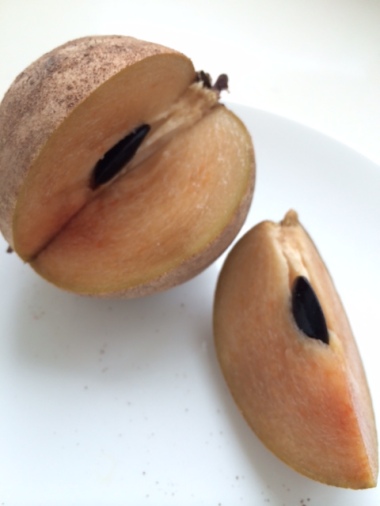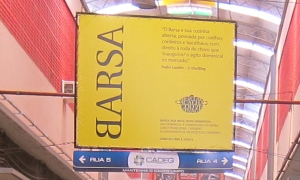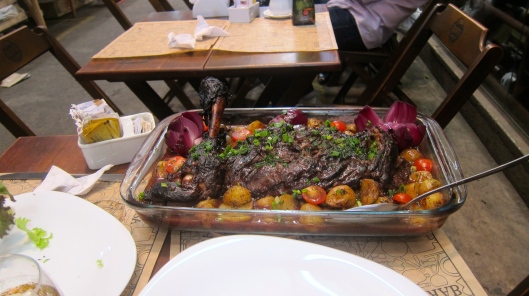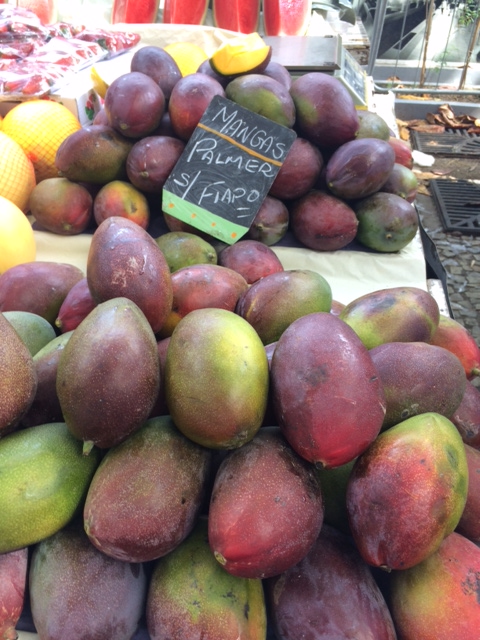
Your cooking techniques can travel around the world with you, but the ingredients you use need to be adapted to where you happen to be. This is especially true in Brazil, where many of the everyday ingredients that one becomes accumstomed to using in Europe or North America — and even more so in Asia — are unavailable here. Most people returning to Brazil after a trip abroad return with suitcases filled with electronic gadgets — which eye popping tariffs make very expensive here — but my own bags are generally filled with cooking equipment, and foreign (especially Chinese and Indian) condiments, spices, and so forth that are simply can’t be purchased locally. But many things can’t be brought from abroad, and a cook needs to become a bit of a sleuth to search them out, or to find ready replacements when necessary. Thoughts of peach pie developed into Mango and Crème Fraîche Streusel Tart.
Tart Shell
100 grams butter (add two pinches of salt if unsalted)
1 Tablespoon of oil
2-3 Tablespoons of water (see notes)
1 Tablespoon of sugar
175 grams of flour
Streusel Crumb Topping
75 grams sugar (preferably glazing or confectioners
1/4 teaspoon of baking powder
6 Tablespoons of flour
75 grams of very cold butter
Tart Filling
1-2 Mangoes (about 350 grams of flesh)
200 grams of crème fraîche
1 pinch of salt
1 Lime/Lemon (about 1 Tablespoon)
Lots of missing ingredients come up when baking in Brazil. A friend who knows that I am always searching for special ingredients to cook with, and knows that I love to make ice cream, told me about some special fresh cream (most of the local milk and cream has been pasteurized half to death) that she found at the Cobal do Humaíta and that she would bring it over for me — with a tacit understanding that it would be returned as ice cream. When she dropped the “cream” off, I immediately saw that it wasn’t cream at all, but instead was something much rarer in this part of the world — and even better — Creme de Leite in Portuguese, or “Crème Fraîche” as its called in English (and obviously in French). Crème fraîche and the related cultured dairy product “buttermilk” are things cooks in Europe or North America take essentially for granted, but finding these things here is almost impossible.
My immediate plans to make ice cream were foiled, but I needed to make something special with the creme fraiche to show my gratitude and have something nice to return to my friend. My first thought for a crème fraîche recipe was the excellent Peach and Creme Fraîche Pie from Smitten Kitchen, one of my favorite baking sites, and one of the best riffs on the Peaches n’ Cream genre. The peaches and cream concept appealed to me, but I would need to Brazilian-ize the recipe a bit.
The first (major) problem . . . no peaches. Brazil has some of the most magnificent fruit in the world, but the peaches are just not great. They grow some here, and fly most in from Chile or Washington State, USA, but they are super expensive and nothing special, and certainly not as good as summer peaches in North America. Brazilian mangoes though, are certainly the world’s best, and plentiful even though its winter here and not the height of mango season, I had been to the market and had some good Manga Palmer on hand — my favorite variety — and thought that these would deliver the right note in place of the peaches.
The second problem was pie crust, and my not being in the mood to make any at that particular moment. North American style pie crust, particularly an all-butter crust, can be a bit of an effort, and though I usually add some chicken fat to my recipe to make it easier to handle, and flakier, I had none on hand at the moment. I did have some nice Danish butter though, so decided to make a French/Belgian style brown butter tart shell — much less fussy.
In North America, people usually make tarts a lot like they make pie pastry, beginning with cold butter that too quickly turns to room temperature and becomes a melty mess that is difficult to roll out and work with. Instead of tilting at the windmill of thermodynamics, the European way simply bypasses the melting butter problem by . . . using butter that is already melted. This technique provides the bonus of a nutty brown butter pastry, and is almost foolproof.
Just take a bowl and weigh out 100 grams of butter cut into a few pieces (if its unsalted add a few pinches of salt), a tablespoon of sugar, a tablespoon of oil — corn or canola is good for a dessert like this, although peanut or olive is better in a savory recipe — and two or three tablespoons of water — three if using European butter, and two if using North or South American butter (which already has plenty of water in it). Stick the bowl in a hot 210º C (410º F) oven, and leave it for 15 minutes.
While you are waiting for your butter to melt and brown, measure out 175 grams of flour. In North America you can use pastry flour if you have it, or “All-Purpose” flour will work fine. In Europe you want Type 45/00 if you have it, or 55/0 will do. In Brazil, Tipo 1 will work — I use Dona Benta Reserva Especial which comes in a vacuum pack — unless you are lucky to have access to something with less protein — I don’t, so I’m using the all purpose Tipo 1. Its always best to use pastry flour for pastry applications like this, and bread flour for bread. The specific varieties almost always have higher and more consistent quality, while the “All Purpose” varieties can be composed of whatever that particular manufacturer wants it to be on that particular day — and sometimes its whatever the manufacturer has left over.
After 15 minutes, you will see that your butter is nicely browned — let it go a bit longer if you want more nuttiness — and bubbling away.

Take your bowl out of the oven — be careful, that bowl is going to be hot! — and use a wooden spoon to mix the flour into it.


The hot liquid will incorporate with the flour and you will be left with a nice blob of brown butter pastry dough. Now the best part: no resting, rolling, or other complications — dump your dough blob directly into your tart shell form and press it out with your fingers until you have brought it up the sides (but don’t make the bottom too thin).
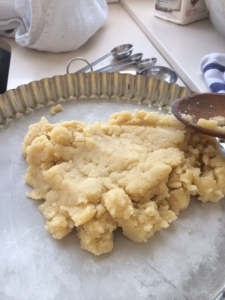
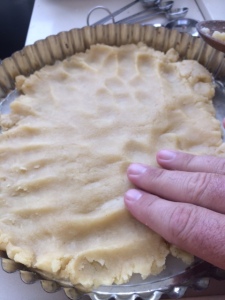

If you have some dough leftover, put it aside to patch any problem areas that develop in the oven. Take a fork and press the edges against the mold, and poke holes in the bottom with the fork tines.
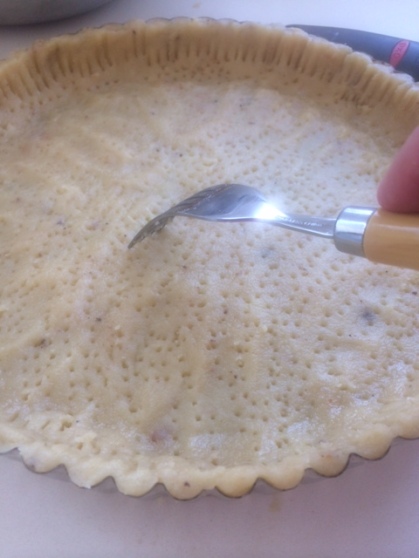
Now partially bake the shell at 210°C (410°F) for 12 minutes until the bottom is brown — the sides will get time to finish browning later.

Once its cool, you are ready to construct your tart. While the tart shell is cooling, you can make your streusel topping. Just combine 75 grams of sugar and 1/2 teaspoon of baking soda with 6 tablespoons of flour, and mix well. Then take a fork or pastry blender and work in 125 grams of cold butter (add a pinch of salt if you are using unsalted butter). Don’t work it too much, and don’t let your crumbs break up to too small or they will melt into the tart.
Now put your tart together. Take a few dollops of crème fraîche and coat the bottom of the shell. This will keep the bottom from getting soggy from the melting mango juices.
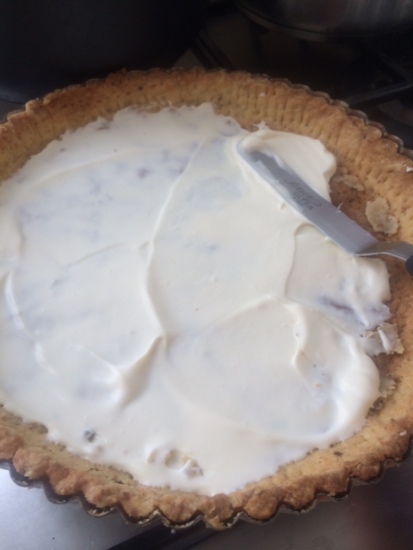
Cut up your mango into wedges. I used pretty big Palmer Mangoes, but you might need two (or more) if using smaller ones. Fit in as many wedges of mango into the tart as will comfortably fit, and top and surround them with dollops of crème fraîche. 
Squeeze the juice of a quarter lemon/lime on top to balance the sweetness from Palmer Mangoes — the sweetest, and best mangoes in the world in my opinion — but omit if you are using a more sour variety. Now top with the streusel crumb mixture, and its ready for the oven.
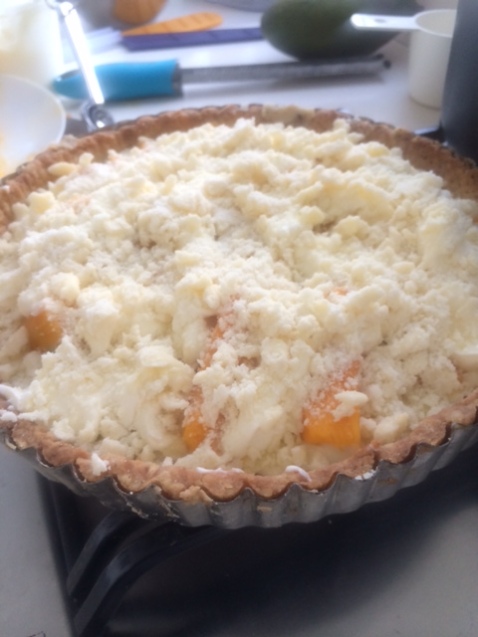
Bake for about 35 minutes at 205C (400F), or until your crumb topping turns brown and your crème fraîche is bubbling. 
Try to wait until it cools before cutting into it.

If you are in a temperate climate, and don’t have access to nice mangoes, you can use whatever fruit you have available locally. Peaches or nectarines would obviously work, and strawberries n’ cream is a classic combination. If you are in the tropics, jackfruit or durian should match beautifully with the cream — though I know from experience that the best durians seem to appear in places with the worst access to crème fraîche. If you are using fruit that isn’t quite ripe or already sweet, you can macerate it for a few moments by sprinkling some sugar and lemon juice on top to soften it a bit.
If you make this, please let me know how it turned out, what sort of fruit you used, and where you made it.


